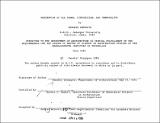Perception of old towns, historicism, and temporality
Author(s)
Sengupta, Ranabir
DownloadFull printable version (9.577Mb)
Other Contributors
Massachusetts Institute of Technology. Department of Architecture.
Advisor
Sandra C. Howell.
Terms of use
Metadata
Show full item recordAbstract
The crux of this inquiry deals with one of the qualities which have been attributed by architectural and urban design theorists to the old, traditional town - its overwhelming sense of visual unity. In this study, it is argued that this unity is somewhat of a perceptual aberration which might arise out of structuring the perceptions of the old town in terms of its common denominator of oldness. The all-pervading sense of age could, to a certain extent erase other irregularities, so that the old town may be cognized with a powerful sense of unity. The first part of the study plants this central issue within the larger context of architectural theories and practice. Certain aspects of the theories of Christopher Alexander and Aldo van Eyck which are contingent upon the issue of the old town are expounded. The issue is also linked with the widespread architectural movement in the eastern world to create a culturally and socially responsive architecture. An important corollary of this movement is the imagery of the old town. The second part of the study deals with a perceptual test conducted to gain some insight into how old buildings are perceived. Rome has been taken as a case for this inquiry. Finally, in the third part, attempts are made to explain the results of the test through phenomenological means. Certain notions of temporality which impinge upon the perception of the old town are briefly touched upon. The social and cultural intentions with which architects seek inspiration in such towns are also touched upon to gain a greater understanding of the central issue.
Description
Thesis (M.S.)--Massachusetts Institute of Technology, Dept. of Architecture, 1986. MICROFICHE COPY AVAILABLE IN ARCHIVES AND ROTCH. Includes bibliographical references (leaves 155-162).
Date issued
1986Department
Massachusetts Institute of Technology. Department of ArchitecturePublisher
Massachusetts Institute of Technology
Keywords
Architecture.